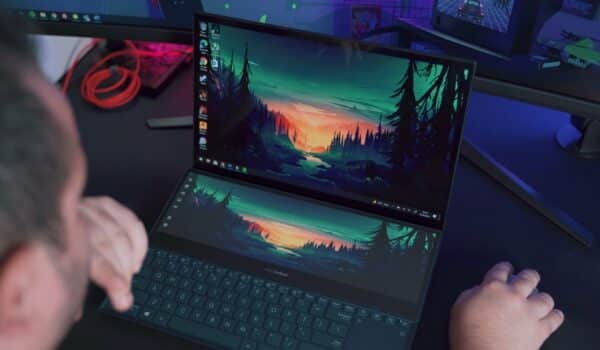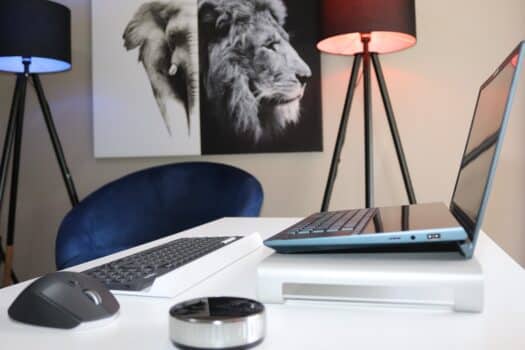Whether searching for a PC for your interior design business, or the best laptop for architects, Asus has it all.
This Taiwan-based company is known for its wide range of computing hardware for consumers and corporations and is among the top three notebook suppliers globally. Asus laptops are known for their sturdy build quality and innovative features, all available at a comparatively reasonable price.
And if you’re looking for a laptop for interior designing, then their Zenbook line is worth taking a look at. It includes all the top-end laptops from the brand with the most impressive specs and is designed to provide the best user experience.
But since the Zenbook series contains multiple models, selecting the right one might be challenging for you. That’s why we’ve decided to share this guide here, explaining the features and differences between the most popular options in detail.
So, let’s dive in!
Asus Zenbook Laptops For Interior Designers

The Zenbook lineup from Asus includes both Pro and Non-Pro models, so let’s start with the Pro models.
Asus Zenbook Pro Laptops Models
1. Zenbook Pro Duo 15
The Zenbook Pro Duo is an immensely powerful machine perfect for all sorts of tasks requiring high-level processing or running graphically-intensive applications. This is possible due to its impressive internals, which include the latest Intel core i9-12900H processor, 32 GB LPDDR5 RAM, and GeForce RTX 3060 GPU.
These allow you to easily run the heaviest programs like AutoCAD, Autodesk Max, and others generally used by interior designers. It also has a 15.6 inches 4K OLED matte touchscreen display that produces bright and vivid colors and offers excellent viewing angles while reducing glare and reflections.
And speaking of the screen, this laptop features the ScreenPad Plus technology from Asus, powered by the ScreenXpert software. It is a secondary screen that is tiltable and allows you to multitask easily, whether calculating room space, working on designs, or editing blueprints.
The storage onboard is enough for most people, as you get 1TB PCIe NVMe M.2 SSD. This also delivers some of the best read-write speeds in the segment, helping complete even the most intense operations quickly without lag.
As for the operating system, the machine comes with the latest Windows 11 Pro, so you do not need to worry about updating the system after purchasing it. However, keep in mind that the Zenbook Pro Duo 15 is quite an expensive option, even though it delivers outstanding performance.
2. Zenbook Pro 14 Duo
The Zenbook Pro 14 Duo is another interior design laptop from Asus that comes with a host of features and is a highly compelling choice. It is powered by the Intel core i9-12900H processor, which can handle all types of tasks, making it one of the best interior designer laptops.
Coming to the display, you get a 14.5 inches 2.8K OLED screen that runs at 120 Hz and helps in making this a compact and lightweight device. It is also Dolby Vision certified and PANTONE validated, so you can rest assured that the colors are displayed accurately.
Furthermore, the ScreenPad Plus feature is present here along with the secondary touchscreen, and you can tilt the screen and easily adjust it to your comfort levels. This touchscreen can also be used with the Asus Pen, which allows you to write and draw on it, a highly convenient utility for interior designers.
Another thing that makes this one of the best laptops for interior design is the Nvidia GeForce RTX 3050 Ti discrete GPU, with 4GB VRAM. This makes running graphics-intensive applications easy, while for storage, you get 1TB M.2 NVMe PCIe SSD.
Due to that, there is adequate storage space for all your interior design project files, and the battery life is also great, making this a costly but powerful laptop.
Zenbook Non-Pro Models

1. Asus Zenbook 14X
The Asus Zenbook 14X has several features that make it ideal for an interior designer, the first of which is the 5.65 inches interactive touchscreen trackpad. This offers greater control and makes multitasking easier, so you can quickly switch from one application to another.
Additionally, the laptop has a 14.5 inches OLED touchscreen display, with a screen resolution of 2880 x 1800, offering crisp viewing angles and vibrant colors resulting in high-resolution images. It is also Pantone validated and can be tilted to 180 degrees for comfortable viewing. And the viewing experience is further enhanced due to the ultra slim bezels, which offer more screen real estate.
The Asus Zenbook 14X comes with the latest 12th-gen Intel core i7-1260P processor, which is also present in powerful machines like the Microsoft Surface Pro. It can handle heavy work loads easily and is an excellent choice for any professional interior designer.
For running graphics-intensive operations, there is the discrete Nvidia GeForce MX 550 GPU, which delivers unparalleled performance, making it ideal for interior design projects. This means that CAD applications requiring heavy graphics processing can be easily run on this machine.
Moreover, the battery life is excellent, and you can easily impress your interior design clients with this machine without needing to spend a lot.
2. Zenbook 14X Space Edition
The Space Edition of the Zenbook 14X comes with some unique features that are not present on the regular version of this laptop. It has a 3.5 inches OLED display with ZenVision technology on the lid, which can be used to view notifications, text, and animations.
This machine also has a sturdy build with a lightweight aluminum body that conforms to the MIL-STD 810H military standard, making it a highly reliable laptop. Additionally, the long battery life lets you work and create for longer periods.
Coming to the main screen display, this retains its 14.5 inches size, with a 2.8K display resolution, 16:10 aspect ratio, and full touch screen support. It is also one of the interior design laptops with very slim bezels, which the manufacturer calls NanoEdge bezels, and which provide the laptop with a 92% screen-to-body ratio.
This provides a larger viewing area and makes it a joy to work on the laptop, especially since the display is Pantone validated as well.
The 12th gen Intel core i9-12900H processor powers the laptop, delivering powerful performance in all applications. It is coupled with the in-built Intel Iris Xe graphics, which can easily run all the latest interior design software like AutoCAD or other 3D modeling applications.
Factors To Consider
While all of the four options are fantastic, selecting one from them requires considering various factors, such as:
1. Processor
You need to have a powerful CPU for running heavy software applications like AutoCAD, generally used by interior designers. Going with the latest Intel core i7 or i9 processors is a good choice for meeting the requirements of interior design students and professionals, though such machines can be costly.
That’s why you should also consider laptops with the latest i5 processors, which are quite powerful and can deliver great performance.
2. RAM
When selecting a laptop for interior design purposes, go with an option with plenty of RAM. RAM is required to perform multiple tasks, and a greater amount of RAM will allow for working on multiple applications at the same time. For interior designing, select a laptop with at least 16GB of RAM, which will help you keep multiple windows open for multitasking.
If possible, go with a 32GB option, and look for a machine in which more RAM can be added if required.
3. Storage Capacity
Having a larger storage capacity will allow you to store more files on it without worrying about running low on disk space. Modern laptops come with SSDs instead of traditional hard drives since they are faster and more durable. Some options may include both, but you should opt for a model with at least 512 GB of SSD storage for storing large interior design files.
Going with an SSD will offer the additional benefit of greater speed while performing various operations and also minimize the chances of data loss.
4. Screen Size And Resolution
Laptops are available with several different screen sizes, with the two most common sizes being 14.5 inches and 15.6 inches, though some may have larger or smaller screens. The screen should provide a comfortable viewing experience without causing any strain.
For that, look for laptops with anti-glare, matte finish screens with thin bezels that provide a larger viewing area, especially with a touchscreen laptop.
As for the resolution, the most common ones include HD, Full HD, 4K, and 8K. Generally, machines with a higher resolution tend to be costlier, but if possible, go with laptops offering at least 2.8K or 4K resolutions. These resolutions provide clearer, sharper images and make working on various projects enjoyable.
5. Connectivity Options
Interior designers often need to connect their laptops to other devices such as cameras, smartphones, and tablets. That’s why you should look at the connectivity options available. The latest models come with Wi-Fi 6, Bluetooth 5, multiple USB ports, and even an SD card reader. There should also be one HDMI port for connecting to an external monitor.
6. Additional Features
You may want to consider other features if they are required to improve your workflow, such as a backlit keyboard, Type C ports, etc. Touchscreen support is another one of these features and can make working on graphics-intensive applications easier.
Some laptops even offer an optimized cooling system, which can help maintain consistently good performance by ensuring proper heat dissipation. Others may offer greater adjustability, like a 180-degree tilt system, which allows you to work more easily by adjusting the laptop according to your comfort levels.
Asus Zenbook Pro Laptops Frequently Asked Questions ?
Is A Graphics Card Needed In Laptops Used By Architects?
Do architects need graphics card is a fairly common question asked by many people. To answer it, we’ll need to explain the purpose of such cards. A graphics card is designed to complete graphics-intensive tasks which the CPU cannot handle effectively. These generally include graphics design software, drawing applications, and games.
While the top-end processors generally have inbuilt graphics handling capabilities that may be able to support these applications, it is better to get an additional graphics card. This is especially true for those in creative industries like architects, digital artists, and interior designers since they need to use software that requires a high level of graphics processing.
Is The Apple MacBook Pro A Good Laptop For Interior Designers?
The Apple MacBook Pro features a 14.25 inches retina display with 512 GB storage and 16GB RAM. It also has three Thunderbolt ports and all the features an interior designer needs, such as a powerful processor and durable build, making it a fantastic choice.
However, you won’t be able to run software applications exclusive to the Windows platform easily on a MacBook, though some alternatives are available on the Apple app store. So, consider the software applications you need to use when choosing between an Apple or a Windows machine.
Can Interior Designing Students Use A Gaming Laptop?
Gaming laptops generally come with very powerful components since games require a lot of processing power. They generally have the latest high-end processors, a large amount of RAM and storage, and multiple connectivity options.
Also, such laptops have excellent graphics processing capabilities due to discrete or integrated GPUs, which are used by design software as well. This makes them a good option for students pursuing graphic design courses.

Asus Zenbook Pro Laptops Final Thoughts
Asus is among the best laptop brands for architects, interior designers, and digital artists, and its Zenbook line is an incredibly popular choice for work and entertainment purposes. Both the Pro and Non-Pro options have some amazing features that can make your workflow smoother, faster, and more enjoyable.
And while it may seem difficult to select one from these four options, keeping in mind your particular requirements can help you make the right choice. It may also be helpful to compare these options with those from other brands like Dell and HP before deciding.
This will provide you with more information and simplify the process of selection. On that note, it is time to conclude our guide. Goodbye!


